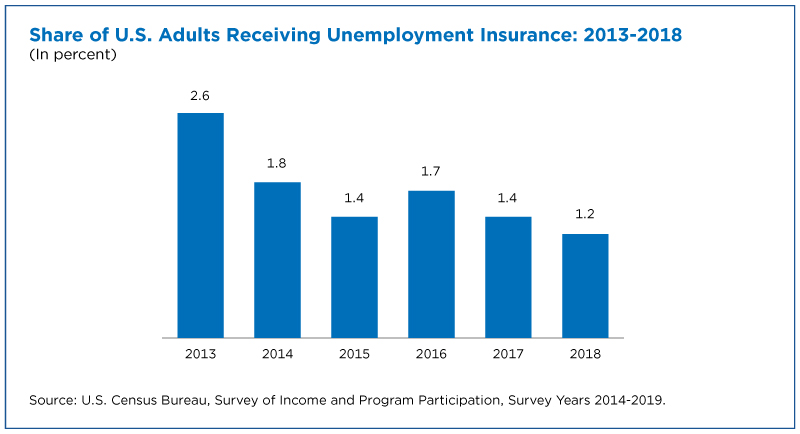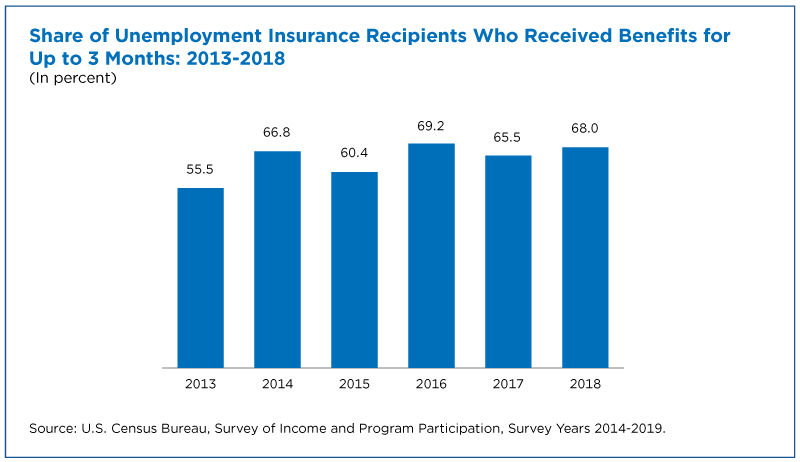
Will unemployment insurance after pandemic follow same path as after Great Recession?
Fewer received unemployment as U.S. recovered from Great Recession
Unemployment Insurance After the Great Recession
The following decade was a time of economic recovery. In fact, 2018 marked the ninth consecutive year of the longest post-WWII expansion, which lasted through February 2020 until the pandemic took hold in the United States.
The Great Recession unemployment rate peaked at 10% in October 2009, but the lingering effects of the recession and the availability of extended benefits under EUC were evident in elevated receipt of UI as late as 2013.
.

.
In 2013, 2.6% of adults received UI at some point. However, by 2018, the share of adults that received UI had been cut in half to 1.2%.
.

.
As the share of Americans receiving UI fell, more received the benefits for shorter periods except in 2015 (when the share of recipients of up to 3 months of UI was about the same as in 2013).
In 2013, just over half of UI recipients collected the benefits for three or fewer months; by 2018, nearly 70% of recipients collected UI for three or fewer months.
UI Transformed During COVID-19
The federal government responded to the challenges of the COVID-19 pandemic by transforming the UI program.
The program underwent several temporary changes under the Coronavirus Aid, Relief, and Economic Security Act (CARES) Act enacted in March 2020. Weekly benefit checks were increased by $600 and the number of weeks of benefits available were extended.
Plus, it created the Pandemic Unemployment Assistance (PUA) program, allowing individuals who were not previously eligible for regular UI — such as workers with shorter work histories, self-employed workers, independent contractors, and gig workers — to receive benefits if their employment was affected by COVID-19.
Administrative UI data from the Department of Labor show the magnitude of disruption and changes to the UI program triggered by the pandemic. In the second quarter of 2019, before the pandemic hit the United States, 2.6 million UI claims were filed. In the second quarter of 2020, 33.7 million claims were filed.
What Happens After the Pandemic
Will UI follow the same trajectory in post-pandemic recovery as after the Great Recession?
Data from the Census Bureau’s experimental Household Pulse Survey (HPS) show that UI receipt remained high although economic conditions improved by the summer of 2021. By June 2021, 6.8% of adults in households reported receiving UI in the first half of 2021.
SIPP and HPS data also show that the profile of UI recipients changed in the wake of the pandemic-related economic disruption and changes to the UI program.
In 2018, SIPP data show that about 60% of UI recipients were non-Hispanic White adults. HPS data show that in June 2021, about 50% of all those who reported receiving UI since January were non-Hispanic White adults.
In 2018, about 30% of those who received UI had a bachelor’s degree or higher, according to the SIPP. In June 2021, the HPS found that only about 20% of adults who reported UI receipt had at least a bachelor’s degree.
The living situation of UI recipients has also changed during the pandemic. The SIPP data from 2018 show that 15.6% of UI recipients lived alone. By June 2021, the HPS shows that only 7.0% of households that reported receiving UI that year were single-person households.
About the Data
SIPP is a nationally representative longitudinal survey administered by the U.S. Census Bureau that provides comprehensive information on the dynamics of income, employment, household composition, and government program participation.
For technical documentation and more information about SIPP data quality, please visit the SIPP website’s Technical Documentation page.
HPS is designed to provide near real-time data on how the pandemic is affecting American lives. Information on the methodology and reliability of these estimates can be found in the source and accuracy statements for each HPS data release.
Data users interested in state-level sample sizes, the number of respondents, weighted response rates, and occupied housing unit coverage ratios can consult the quality measures file available at the same location.
All comparative statements in this report have undergone statistical testing and, unless otherwise noted, all comparisons are statistically significant at the 10% significance level.
The June 2021 data were collected from June 23-July 5, 2021 during week 33 of the survey. The Census Bureau sent invitations to 1,042,285 households and received a total of 66,262 responses, for a weighted response rate of 6.3%.
Source: US Census Bureau






